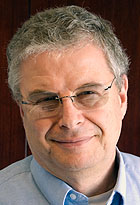The National Institutes of Health (NIH) has awarded School of Medicine scientists four grants totaling $19 million to explore the trillions of microbes that inhabit the human body and to determine how they contribute to good health and disease.
The grants are part of the Human Microbiome Project, an ongoing, ambitious effort to catalog the bacteria, viruses, fungi and other microorganisms that naturally coexist in or on the body.

Weinstock
On June 23, the NIH announced $42 million in grant awards to 12 U.S. institutions that expand the scope of the microbiome project. The largest chunk — $16 million — goes to Washington University’s Genome Center, which played a central role in the initial phase of the project.
George Weinstock, Ph.D., professor of genetics and associate director of the Genome Center, will lead the effort to decode the DNA of about 400 microbes in collaboration with scientists at three other large-scale DNA sequencing centers. This information will be used to catalog the microbes found in samples from healthy human volunteers to find out which microbes live in various ecological niches of the body.
“We can’t really understand human health and disease without understanding the massive community of microorganisms we carry around with us,” Weinstock said. “This effort will tell us which microbes are present in certain areas of the body and what they are doing there. Ultimately, this information will change how we think about and treat many illnesses.”
Many scientists consider humans as superorganisms, a synergistic community of both human and bacterial cells that is more than the sum of its parts. The microbial cells in the human body are major players: They outnumber human cells by at least 10 to one.
Moreover, our bodies carry more than 100 times as many microbial genes as human genes. These microbes contribute essential functions that humans have either lost or never been able to perform on their own, such as synthesizing certain vitamins, digesting complex sugars or helping the body to ward off harmful disease-causing microorganisms.
WUSTL researchers also received $3 million for three pilot demonstration projects that investigate the link between changes in microbial communities and certain diseases. These one-year projects involve sampling the microbiomes of both healthy and ill volunteers. By comparing differences in microbial communities between the two groups, researchers hope to determine how microbes influence the risk of disease.
Ellen Li, M.D., Ph.D., professor of medicine and associate professor of biochemistry and molecular biophysics, is evaluating whether patients with Crohn’s disease, a gastrointestinal illness that causes severe abdominal pain and diarrhea, have a genetic makeup that alters the types of microbes that colonize the intestinal tract. She and her colleagues suspect that mutations in the human genome combine with changes in the composition of intestinal microbes to cause the inflammation that is the hallmark of the disease.
Gregory Storch, M.D., the Ruth L. Siteman Professor of Pediatrics and professor of medicine and of molecular microbiology, is working to uncover the full spectrum of viruses that cause sudden high fevers in otherwise healthy children. His team will analyze blood samples and respiratory and gastrointestinal secretions from children with fever and healthy children to look for both known and new viruses.
This information will provide a basis for understanding how viruses may contribute to fevers that cannot be traced to a recognized cause. The scientists also will carry out similar studies in children whose immune systems are suppressed, either by HIV/AIDS and other illnesses or by medications related to organ and stem-cell transplants.
Phillip Tarr, M.D., the Melvin E. Carnahan Professor in Pediatrics and professor of molecular microbiology, is investigating whether necrotizing enterocolitis, a devastating gastrointestinal illness that primarily affects premature infants, is linked to microbes in the intestinal tract.
Tarr and his colleagues are collecting fecal samples from premature babies to identify and quantify differences between the microbial communities of the infants who develop the illness and those who do not. This information may provide a foundation for developing ways to prevent or cure the illness.
The Genome Center also will collaborate on two additional pilot demonstration projects. One probes the link between the skin microbiome and acne in a project led by researchers at the University of California, Los Angeles. The other examines the microbiome of the urethra in adolescent males and its relationship to puberty, sexual activity and sexually transmitted diseases. Projects with encouraging results may be selected for expansion and additional funding.